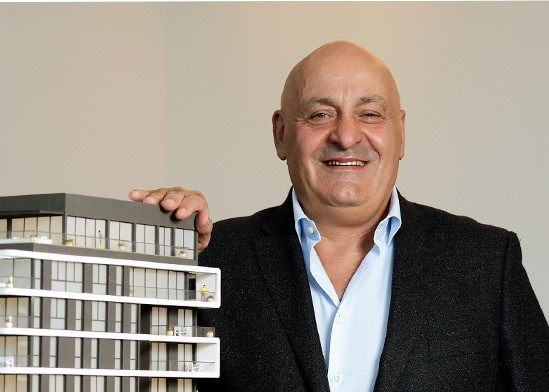Globes, Halit Yanai-Levison, 15.09.2020
The problems:
1. Lack of manpower in local authorities
"The engineering departments in most of the authorities are functioning with a huge shortage of manpower," says Hanan Moore, chairman of the More Group.
Adv. Vered Tzarfoni Zevulun, vice president at French company Shimon and vice president of the Builders Association of Builders Association, adds that "projects usually get stuck in each municipality's local licensing committees. The delay in issuing building permits is a direct result of a shortage of skilled and professional manpower in municipal authorities" .
 French Rose Zebulon / Photo: Avi Rokach
French Rose Zebulon / Photo: Avi Rokach
According to Moore, "Various officers in the engineering units at the various ranks (from program reviewers to city engineers) are dragging their feet in reviewing the plans. They pass the comments on the plan amendments in several rounds, and much of it is done 'behind the scenes' rather than the online system. The reviewers of the plans reject the request, thus bridging the gaps in the schedules set by the law. "
2. Inefficiency of an available licensing system
According to French Zebulon, working in the online "Licensing Available" system for document submission and process management requires the local authority to review applications and respond to them within a quarter. "It seems seemingly effective, except that this period of time does not allow the authority to review the plans in all the planning departments in the municipality."
Yigal Govrin, chairman of the Association of Engineers and owners of the project management company Waxman-Govrin-Geva, "Entrepreneurs will embrace you today if you bring a permit within a year, and at best for two years. A friend of mine who is a city engineer said that the available license is everything but being available. It only increased the pressure that was exerted. "
Shalom Sheetrit, CEO of Shitit, uses even more harsh words: "This system should be renamed and called 'unavailable licensing.' It only made the situation worse. There are cities where the system has turned. It is worse than the Soviet bureaucracy. "
 Shitit CEO, Shalom Sheetrit / Photo: PR
Shitit CEO, Shalom Sheetrit / Photo: PR
3. Many objections from different directions
According to Yossi Avrahami, owner and CEO of Yossi Avrahami, the objections often cause significant delays in projects, more than any other factor.
The objections are almost the only options for the public and the victims of a plan to express their opinions.
Avrahami: "These are not always substantive objections related to the impact of the project on the environment, but many times there are those submitted out of foreign interests. Any objection can take us to an appeal committee, where we wait for many months."
 Yossi Avrahami / Photo: Eyal Yitzhar, Globes
Yossi Avrahami / Photo: Eyal Yitzhar, Globes
4. Uncertainty due to role swaps
Advocate Vered Tzarfoni Zevulun: "When there is a change of position - a mayor, a committee member or a new engineer entering the position - the planning ship is undermined. The committees change their policies, stop approving permit applications according to the old format and cancel applications that have been in the pipeline for at least a year and a half and are awaiting approval. It is common. Any rejection by a committee drains many years of work.
"For example, a large city is planned to be built with a new neighborhood with more than 1,000 housing units. After many agreements with the municipality, it was decided to cancel the easing that allows for additional apartments. This dragged the project back to planning." The architect. "
In general, according to the Frenchman Zebulon, the need to submit an architectural plan should be eliminated as a precondition for opening a licensing case. "It is basically a kind of permit - a permit within a permit - that delays the main permit. This plan requires the submission of an application detailing a full building permit and for this purpose the developer is required to bring permits from a group of external consultants.
Michal Gur, CEO of the coral public construction company, notes that the exchange of positions in the local authorities also adds to the difficulty: "Sometimes after the developer purchased land and went through a long process of early planning while coordinating and pre-rolling with a planning committee official, The new one has a different agenda that does not match the existing design and this forces the developer to either clash with the planning authority (which is usually not recommended) or redesign, thus causing double costs, high financing costs on the land, and a significant delay in the licensing process.
Excess bodies related to the issuance of permits
Michal Gur, CEO of the coral entrepreneurial company, states that not only the authorities lack manpower, but also the other bodies that need to issue approvals: " "As limited manpower standards, a bottleneck has been created. We as entrepreneurs have to wait in line for a long time in order to get the desired approvals even as a threshold condition for a committee permit discussion."
According to Avrahami, "We invest a lot of time and manpower in front of stakeholders such as firefighters and the electricity company."
Not just real estate: how to invest outside the capital market and diversify your portfolio?
"Today, the developer has to take care of coordination between the requirements of different ministries - more than in the past. For example, the developer has to deal with authorities like the Water Authority, the Airports Authority," says Yossi Praszkowski, chairman of Praszkowski. There are more conditions that need to be met, and that too more than ever. "For example, we recently came across a demand for a permit from the Ministry of the Environment - something that delayed us for more than three months."
 Yossi Praszkowski / Photo: Geva Talmore
Yossi Praszkowski / Photo: Geva Talmore
In Israel," says Guvrin, "the information file that is received from the local authority covers three-quarters of the information, and another quarter is unknown to them as well, and then it is discovered in the field and the work is stopped. In a project we received approval from Bezeq, when we started the work we discovered a line they did not know about and stopped the work for three weeks. This is significant.
"They took the control institutes, said we would take the license from the planning committees in the local authorities. As if the private sector knows how to work more efficiently, and release them, and so they also knew how to check and control. In practice what happened, we think the control institutes missed their purpose. "Beyond what they will be able to do. Like the available license you need to get an answer within 45 days."
"Once upon a time there were four municipal officials on 400 square meters, and when a contractor came in he issued a permit in one day," says Yaki Briga, CEO and owner of the Briga company. "Today, there are hundreds of officials sitting in a 4,000-meter building and until you manage to pass the information from department to department - it can take years.
 Yaki Briga, owner of Briga / Photo: Eyal Yitzhar, Globes
Yaki Briga, owner of Briga / Photo: Eyal Yitzhar, Globes
6. Political chaos in the central government
"The system itself is at the seam between the planning committees, which have political representatives, and the engineering departments, which consist of professional manpower in local authorities. To this dysfunction must be added the cumbersome process bureaucracy between municipal and government agencies," says Hanan Moore.
 Hanan Moore / Photo: Eyal Toag
Hanan Moore / Photo: Eyal Toag
Different functionaries in the engineering units in the authorities determine work processes as they see fit and interpret the provisions of the master plan or regulations in a different way, and their superiors can interpret them in a completely different way.
"These differences create chaos, and in the absence of a desire to accept responsibility among government officials and engineers for fear of an unambiguous interpretation of the law, delays and chaos are created.
"Contractors are required to approve a permit application plan in the various municipal divisions in parallel with reviewing plans in the Licensing Department. After months of attempts to approve a permit application plan by the various municipal divisions, the Licensing Division requests updates that force the contractor to return to the starting point and re-seal municipal divisions.
"Local engineering and politics departments are using the power in their hands to put pressure on developers and tenant-price tenants, who will put pressure on places where municipal authorities are helpless in the face of government. It should not be like that."
Yigal Govrin, chairman of the Association of Engineers, is troubled by the need for personal connections: “When you make the licensing issue a personal matter, how much the architect knows someone, and so far you have connections in firefighting, it is not good. He must not work like that.
 Yigal Govrin, Chairman of the Association of Construction and Infrastructure Engineers
Yigal Govrin, Chairman of the Association of Construction and Infrastructure Engineers
Photo: Yachz
7. New licensing requirements
"Years ago the issue of licensing was relatively simple because there were not many requirements that had to be met," Govrin explains. "As the years went by, things were added that needed to be considered - electromagnetic radiation, accessibility, tree preservation, use of hazardous materials."
According to Yossi Praszkowski: "The issue of green construction changes from day to day, every day there is a new regulation or idea - there is no uniformity between the authorities and the result is dragging one's feet and extending the time for a permit."
According to Sheetrit, "a building permit that can be issued in a year and a half or two years comes to four years. Each factor takes time.
8. Gaps between different local authorities
According to Sheetrit, "There are very orderly and clear authorities like Tel Aviv and Tivon, where there is a practical approach to promoting building permits. Workers are organized and want to move forward. In contrast, there are other places that do not understand that stopping building permits stops the authority itself." They pose difficulties for entrepreneurs.
"By the way, the same difficulty in obtaining permits also leads to difficulty in obtaining Form 4. A fire permit is a must, but it can be stopped for nonsense. We now have two buildings waiting for Form 4 because of cladding! For that stopping a population of buildings? It's not something engineering at all. ".
The solutions:
Cancellation of the reliefs, including Shebes and Kahlon
The director general of the Planning Administration, Dalit Zilber, stated about a year ago that a dramatic move would be made, according to which the possibility of requesting the reliefs would be eliminated, including the easing of the window.
Zilber believes that the abolition of the facilities will improve the planning - because what is planned is what will actually be built - and will also dramatically shorten the licensing process. The Ministry of the Interior recently announced that the cancellation of the relief will be included in the forthcoming Arrangements Law in order to speed up the process.
Yigal Govrin, chairman of the Association of Construction and Infrastructure Engineers, believes that "if the Planning Administration succeeds in this abolition - it is a welcome direction. "Once they introduced the Shebes relief and then the Kahlon relief, it created a model in which movement is very problematic." Tel Aviv municipal engineer Udi Carmeli also believes that the duplication of licensing and planning is problematic.
2. Self-licensing by the architects
"In the U.S., I know of projects I've been involved in. You usually get a permit within three weeks, sometimes within a month," Govrin says. "It doesn't happen because Americans are so effective, but because the method is different. When an architect submits an application for a permit, they want him to sign that the application is submitted according to the existing master plan. He commits to this. They have no idea of the relief, there are no exceptions.
"If the architect signed the plan and it is incorrect, the license went to him. In some cases they require a drainage plan, because of the issue of flooding. They do not ask for permission from the power company, telephone, fire department, forest official, water corporation. They assume all planners are Serious people who do their job faithfully.That is when the architect set the zero line of the building, he first went to the water corporation and according to that set the pit height of the taps, and got all the information he needed from firefighters.
"There can be mistakes, but by definition whoever gives information gives it properly."
The Frenchman Zebulon also believes that a move should be made for self-licensing: "The stage of submitting an architectural design plan should be canceled - there is no need to submit a double building permit. Self-licensing should be promoted so that architects can approve building permits almost without local planning committee involvement."
Moore: "Self-licensing, integrated work and giving responsibility to architects, along with inventing metrics that are in line with reality - are what will lead to the solution of the endless traffic jam in the entire process of issuing building permits.
"The shortcut could lower the prices of new apartments by 5% -10% tomorrow morning."
According to Govrin, "the model that exists in the United States should be adopted. I'm pretty sure if they let the private sector handle this, things would look different. If there is self-licensing, and they see that a certain professional has nonsense, then they will stop working with him. There will actually be an increase in the level of professionalism of the field. Nobody benefits from an entrepreneur sitting on the ground for three years. "
Is this true for any type of project?
Self-licensing can be done even in a large urban renewal project, once they have defined that no relief is possible. There are very serious planners in the country. It's not because of the weeds that we have to give it up. "
3. The series and a common working method
According to Hanan Moore, "It is possible, possible and desirable to carry out a reform in the issuance of building permits. Instead of developers spending years in dialogue with the various teams in never-ending processes. This requires a convergence of a joint working method of all stakeholders.
"In order to resolve the bureaucratic chaos, the series must be produced and coordinated processes established between authorities and the various engineering departments, along with clear role definitions and responsibilities for each professional and clerk who comes in contact with the permit issuance procedure. In lists that last months and even years.
"Real and accurate indices for obtaining permits must be produced. The situation today is inaccurate and very far from reality, to say the least. The receipt of a building permit must be measured from the date of issuance of an information file. In such a measurement we will see that the schedules sometimes extend to years as well. Unreasonable time on a global scale. "
According to Yossi Praszkowski, "The committees should convene a round table in which all stakeholders will participate. During this process, all parties will be able to comment on all comments at once and then the developer will know what he is dealing with. There are already authorities implementing this process. From one office to another to obtain a permit, proof that licensing issues can be resolved quickly and efficiently is the WTO (National Infrastructure Committee) which promotes programs at the national level efficiently and quickly while paying attention to all the required details. You can learn from that if you want to - it is possible. "
Sheetrit gives another example of things that are progressing fast: Permits for public construction: "In public construction, everything works much faster, because the authority has a personal interest and everything flows. The fact that the system can work fast is a matter of attitude."
Michal Gur from Coral: "There must be full coordination between the local authority and the regulator! Before the state wants to market land it owns, it must be coordinated with the local authority, does the local authority have the ability to provide infrastructure for the project. The final. "
 Michal Gur / Photo: Eyal Yitzhar, Globes
Michal Gur / Photo: Eyal Yitzhar, Globes
Avrahami and Sheetrit think that an example can be taken not only from what is happening abroad, but also from the Tel Aviv Municipality. Avrahami: "The Tel Aviv Municipality holds professional planning forums and is one of the only authorities ".
Sheetrit: "In the Tel Aviv municipality, teams have been set up by region, and they bring everyone together and try to provide solutions."
4. Extension of powers to the local committee
According to Avrahami, a professional planning forum should be set up in the local authorities with bodies with authority to make decisions. "The developer usually encounters archaic lawsuits, which do not suit the changing needs of the real estate market and often require a change in local or district procedure. Here, too, the increasing powers of local committees to change the scope of building rights and planning decisions in their jurisdiction should be considered."
French attorney Zebulon adds that care must also be taken to place professional manpower and the desired amount in the licensing committees, noting that the master plans (city building plans) themselves, too, need to be more flexible: "The planning itself should be more subject to change."
In theory this should take a year: how do you get a building permit? | Adv. Shiran Zandberg
30 days - Submission of an application for an information file The
application is submitted through a professional (engineer, architect or practical engineer) through an online system called "Available Licensing", along with a topographic map and a photo of the lot. The information file will be received within 30 days and will include the instructions for applying for a building permit.
Several months -
collection of permits Collection of permits from a variety of parties - in accordance with the requirements that appeared in the information file and the signing of the landowners, the Israel Land Authority if necessary, safety and accessibility consultants and more. The stamping process sometimes takes several months.
 Adv. Shiran Zandberg / Photo: PR
Adv. Shiran Zandberg / Photo: PR
10 days - confirmation of compliance with preconditions
within ten working days The committee is supposed to issue a certificate that the request meets all the conditions specified in the information file.
90 days - the committee's decision
when it comes to an application without relief, this takes up to 45 working days. If building facilitation is requested, the decision will be made within 90 working days.
5 days - building permit
from the payment of fees and levies After receiving a safety permit, the local committee will issue you a demand for payment for construction fees, levies and improvements. The permit will be received within five days from the date of payment. The permit is valid for three years, provided that construction begins within a year.



